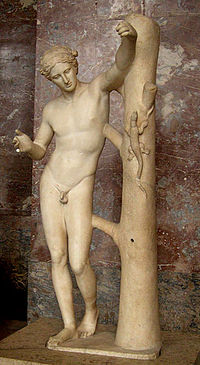Apollon Sauroktonos
The Apollon Sauroktonos (Greek for lizard killer ) is an ancient bronze statue by the artist Praxiteles , made in the middle of the 4th century BC. It depicts Apollo as a boy who leans against a tree trunk and kills a lizard with an arrow .
The figure could be an allusion to the python-killing Apollo or, if the lizard is an attribute of Apollo, also to the plagues of Apollo. The authorship of the bronze original is attested by Pliny (Pliny, Naturalis historia 34, 69-70). Martial (14, 172) reports that the figure was also reproduced on a smaller scale in Roman times.
A marble copy of Apollon Sauroktonos is in the Vatican Museums (inv. 750), another in the Louvre in Paris (inv. MR 78, Ma 441). The copy in the Louvre is a Roman copy from the 1st or 2nd century AD and formerly belonged to the Borghese collection and was acquired by Napoleon in Naples in 1807 .
Meyers wrote about the artistic design of the Praxiteles in 1888:
Praxiteles goes ... one step further by giving the body a lateral support point. The body hovers between two supports, giving it an extremely soft line, which goes wonderfully with the delicate treatment of the whole figure. The load is distributed between the left arm and right foot. The slight movement of the right arm, in whose hand he is holding the arrow in order to hit the lizard climbing up the trunk, is so casual that a serious attempt at killing does not seem to be considered. The head tilted slightly to one side, the calm facial expression, the softly drawn-up left foot and the curvature of the fingers of the left hand complete the picture of leisurely calm.
Copy in Cleveland
A bronze copy of this sculpture was offered in art dealers in 1991. The specimen was allegedly discovered in 1991 on an estate in Saxony . Since 2004 the statue has been in the possession of the Cleveland Museum of Art (Inv. 2004-30), which proudly called it the most important classical sculpture to be purchased by a North American museum since World War II .
From this figure, science could see how the ancient bronzes were anchored in the base. Through small filling holes in the feet of the statue, lead was poured through the open feet into the underlying cavities of the base, thus firmly anchoring and weighting the figure.
In the large Praxiteles exhibition in the Louvre in the summer of 2007, the work of art could not be shown because Greece made demands. The "Archaeological Council" of Greece claims that the sculpture was recovered in the Ionian Sea . In fact, it came from the possession of the art collector Ernst-Ulrich Walter from Leutwitz (Saxony), who claims to have inherited it. After examining the patina it could be shown that the figure was not in the Ionian Sea. The base plate comes from the 17th – 19th centuries. Century.
literature
- Wilfred Geominy : Praxiteles (II). In: Rainer Vollkommer (Hrsg.): Künstlerlexikon der Antike . Volume 2: L-Z. Addendum A – K. Saur, Munich / Leipzig 2004, ISBN 3-598-11414-1 , pp. 305-319.
- Matthias Schulz: Forest spirit in the fishing net . In: Der Spiegel . No. 22 , 2007, p. 138 ff . ( online ).
- Jean-Luc Martinez, L'Apollon sauroctone , in Praxitèle . Catalog de l'exposition au musée du Louvre, 23 mars-18 June 2007, Paris 2007, pp. 203–235.
- Salvatore Mancuso: In the mirror of the copy. The replicas of Apollon Sauroktonos des Praxiteles. In: Vinzenz Brinkmann (Hrsg.): Back to the classic. A new look at ancient Greece. Exhibition catalog Liebieghaus Skulpturensammlung. Hirmer, Munich 2013, pp. 213-229.
